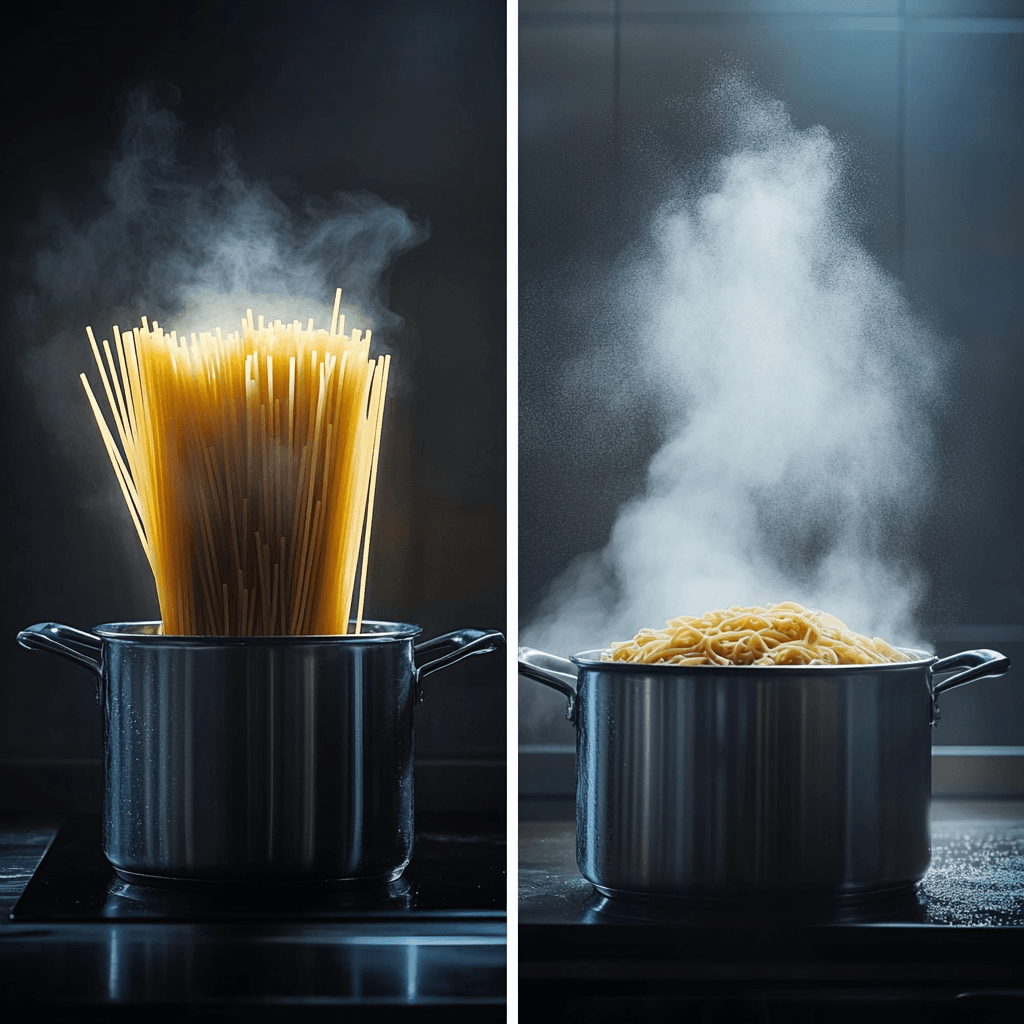After spending years in firehouses across the country, I’ve watched countless well-meaning cooks turn perfectly good pasta into mushy disappointments. The techniques I learned from studying Gordon Ramsay’s methods completely revolutionized how I approach pasta cooking, and the difference is honestly shocking.
The truth is, most Americans have been cooking pasta wrong their entire lives, following myths that create sticky, flavorless results instead of the al dente perfection that pasta deserves.
The Most Common American Pasta Mistakes
Mistake #1: Using Too Little Water Most home cooks use a small pot with barely enough water to cover the pasta. This creates a starchy, sticky mess because the pasta doesn’t have room to move freely. The water temperature drops dramatically when you add the pasta, leading to uneven cooking and clumping.
Mistake #2: Adding Oil to the Pasta Water This is perhaps the biggest myth in American kitchens. Contrary to popular belief, Gordon Ramsay never adds oil to pasta water because it prevents sauce from properly adhering to the cooked pasta. The oil creates a slick coating that causes your carefully prepared sauce to slide right off.
Mistake #3: Not Salting the Water Enough Your pasta water should taste like mild seawater, but most Americans add a tiny pinch of salt that does absolutely nothing. Under-salted water means under-seasoned pasta, and you can’t fix this after cooking.
Mistake #4: Overcooking to Mush Americans tend to cook pasta until it’s soft and mushy, missing that crucial al dente texture that provides the perfect bite. Fresh pasta especially cooks incredibly fast – often in just 2-3 minutes.
Mistake #5: Rinsing After Cooking Unless you’re making pasta salad, never rinse cooked pasta. The starchy coating helps sauces cling properly, and rinsing washes away this natural binding agent while cooling the pasta unnecessarily.
Understanding proper pasta cooking techniques from professional sources can transform your results overnight. The science behind perfect pasta is actually quite simple once you understand the principles.
Gordon Ramsay’s Golden Rules for Perfect Pasta
The 1-10-100 Rule This fundamental rule governs pasta cooking ratios: 1 liter of water, 10 grams of salt, and 100 grams of pasta per person. This ensures adequate water volume, proper seasoning, and correct portion sizes. The large water volume maintains temperature when pasta is added and provides space for movement.
The Salt Timing Rule Add salt only when the water reaches a rolling boil, never before. Salt raises the boiling point of water, so adding it too early means you’ll wait longer for the water to boil. Once boiling, add salt and let it dissolve completely before adding pasta.
The Pasta Water Reserve Rule Always reserve at least one cup of starchy pasta cooking water before draining. This liquid gold contains dissolved starches that help bind sauces to pasta and adjust consistency. Professional chefs consider pasta water an essential sauce ingredient.
The Timing Coordination Rule Your sauce should be ready when your pasta finishes cooking, not before or after. Fresh pasta cooks so quickly that having everything synchronized is crucial. Start your sauce timing based on pasta cooking time, not the other way around.
The Finish-in-the-Pan Rule Never serve pasta straight from the colander. Always finish cooking the pasta in the pan with your sauce for the final 30-60 seconds. This allows the pasta to absorb flavor and creates better sauce adhesion.
When you master these fundamentals, you’ll understand why Gordon Ramsay’s homemade pasta techniques produce such consistently excellent results. The same attention to detail that makes his fresh pasta exceptional applies to cooking any pasta perfectly.
The Science Behind Perfect Pasta Water
The reason for using abundant water isn’t just tradition – it’s physics. When you add pasta to boiling water, the temperature drops. With insufficient water, the temperature drop is so significant that the pasta starts cooking unevenly before the water returns to a boil.
Adequate salt concentration (about 1% by weight) doesn’t just season the pasta; it actually affects the cooking process. Salt helps firm up the pasta’s exterior while keeping the interior tender, contributing to that perfect al dente texture.
The starch released during cooking creates a natural thickening agent in the pasta water. This is why reserving pasta water is so crucial – it contains natural emulsifiers that help create silky, restaurant-quality sauces.
Professional techniques from resources like King Arthur Baking’s pasta guides demonstrate how these scientific principles translate into practical cooking methods.
Advanced Techniques for Perfect Results
The Drop-and-Stir Method Add pasta to boiling water all at once, then immediately stir vigorously for the first 30 seconds. This prevents sticking without needing oil and ensures even cooking from the start.
The Taste-Test Timeline Start testing pasta doneness 2 minutes before the package time suggests. Fresh pasta especially can go from perfect to overcooked in seconds. The pasta should offer slight resistance when bitten but not feel hard or crunchy.
The Sauce-Integration Technique When finishing pasta in the sauce pan, add small amounts of pasta water gradually while tossing. The starch helps create an emulsion that coats each strand perfectly. This technique works whether you’re making simple aglio e olio or complex cream sauces.
Understanding these principles will revolutionize every pasta dish you make. The difference between following these rules and the common American mistakes is the difference between restaurant-quality results and disappointing, amateur-looking plates.
For those ready to take their pasta game to the next level, exploring Gordon Ramsay’s signature pasta dishes reveals how these fundamental techniques apply to specific recipes and flavor combinations.
The most important lesson I learned is that pasta cooking isn’t complicated – it just requires respect for the process and attention to detail. Once you experience perfectly cooked pasta using these methods, you’ll never go back to the old ways.
Stay safe,



